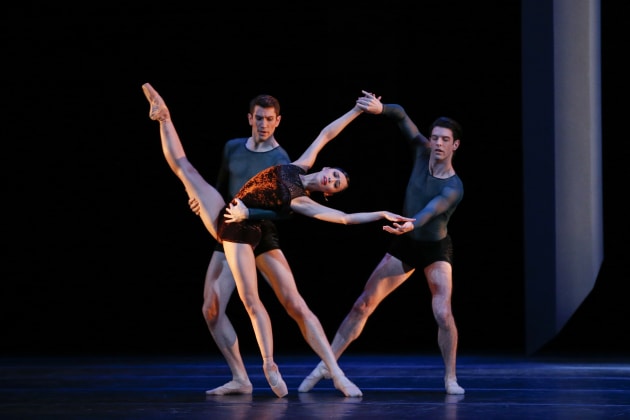THE AUSTRALIAN BALLET: VERVE

Arts Centre, Melbourne
June 22
Verve is a triple bill showcasing the talents of three contemporary Australian choreographers, Stephen Baynes, Tim Harbour, and Alice Topp - that regrettably rare breed, a female choreographer.
In a well structured program the three works presented three different styles of contemporary ballet, from the modern classicism of Baynes's Constant Variants, to the aggressive angularity and athleticism of Harbour's Filigree and Shadow, framing the soft fluidity and expressiveness of Topp's Aurum. Constant Variants and Filigree and Shadow are both already in the repertory of the Australian Ballet, while Aurum was a world premiere and Topp's major work to date. It was also the clear standout of the evening. Hers is a rapidly maturing, fresh and different choreographic voice that is unafraid of beauty, fragility, and a depth of feeling too often missing in contemporary ballet.
Aurum is inspired by the Japanese practice of "kintsugi", the art of repairing cracks or breaks in pottery with gold or metallic lacquer in such a way as to emphasize them rather than conceal, thus turning the flaw into a thing of beauty and an intimate part of the object's history. This translated for Topp into a way of seeing human beings, their "cracks" and imperfections becoming, to paraphrase Leonard Cohen, the places where the light gets in. It is rare to see choreography of such vulnerability and authenticity in the ballet world and it would be good to see more.
Aurum was an accomplished work choreographically, engaging both audience and performers throughout. Movements are unashamedly beautiful, with fluid upper bodies and a preference for harmonious lines and circular rather than angular shapes. The movement is never fixed and there is a sense of groundedness, of not fighting gravity but sinking into it to gain strength from the ground. Alongside the duets, there is good ensemble choreography, with interesting sequencing of groups at the start. At the end the ensemble is well used in a build up of momentum and drama. The transition into a duet when two male dancers become a backdrop for the lead couple is another subtly effective touch.
Leanne Stojmenov and Kevin Jackson led an outstanding and even cast of dancers who allowed themselves to become immersed in the emotional journey of the choreography and the music.
Einaudi's simple yet mesmerizingly emotional music (a reminder that apparent simplicity often requires true mastery) was an integral part of the whole experience with beautiful playing by soloists Brian Cousins (piano), Seiki Ueno (violin) and Melissa Chominsky (cello). The lighting design and staging (Jon Buswell) captured the concept and mood superbly. As the piece progresses an illuminated backdrop of cracks appears, and the whole stage is suffused with a golden glow in the midst of which the dancers are left reaching for the light. The white simple costumes likewise harmonize with the purity and sense of regained innocence of the whole.
Aurum was a work which succeeded in reaching out to touch people's hearts.

Harbour's Filigree and Shadow, which concluded the evening, could scarcely have been a bigger contrast in style and mood. The movement here is sharp, angular and aggressive, and motivated by energy and movement itself. There is little sense of stillness, rather a hurricane of motion which the dancers negotiated with great control. The extreme athleticism and sharply accented movements were a good match for the score by 48nord (Ulrich Müller and Siegfried Rössert) which suffered nevertheless by comparison with the Einaudi and Tchaikovsky’s Rococo Variations (in Baynes's work), and also by virtue of its being a recorded soundtrack juxtaposed to live orchestral performances.
In what is essentially an ensemble piece for 12 dancers, a long male trio is a standout moment, demonstrating their strength and technique. More in this case though is not necessarily always more, as the surfeit of movement can become progressively less engaging. But there is no questioning the prowess of the dancers or the skill of the choreography.

Baynes's Constant Variants, which opened the program, is again another matter entirely, with its classical restraint, playfulness and sense of occasional displacement or disjointedness, both in its backdrop of half-lit partial frames and its interplay of dance segments. It is an essentially musical piece of choreography with the music dictating shifts in mood and structure. There are effective moments of stillness and many breathtaking beautiful "framed" lifts, while the classical vocabulary is treated in a gently innovative way with delicacy and grace to convey subtle shifts in moods.
The work is again essentially an ensemble piece for four couples led by Ako Kondo and Andrew Killian who carry most of its emotional charge.
The silhouette lighting adds a dramatic element, punctuating the work with darkenings of mood, while the solo cello of Teijo Hylkema is a highlight.
In common with the other two works on the program costuming was minimal, the dark brown velvet of the women's leotards making a particularly beautiful effect in the half light.
The dancing throughout the evening was of high quality on the part of all, demonstrating an evenness across company ranks from principals to corps dancers. This kind of repertoire suits the Australian Ballet dancers well.
- IRINA KUZMINSKY
'Verve' continues till June 30.


